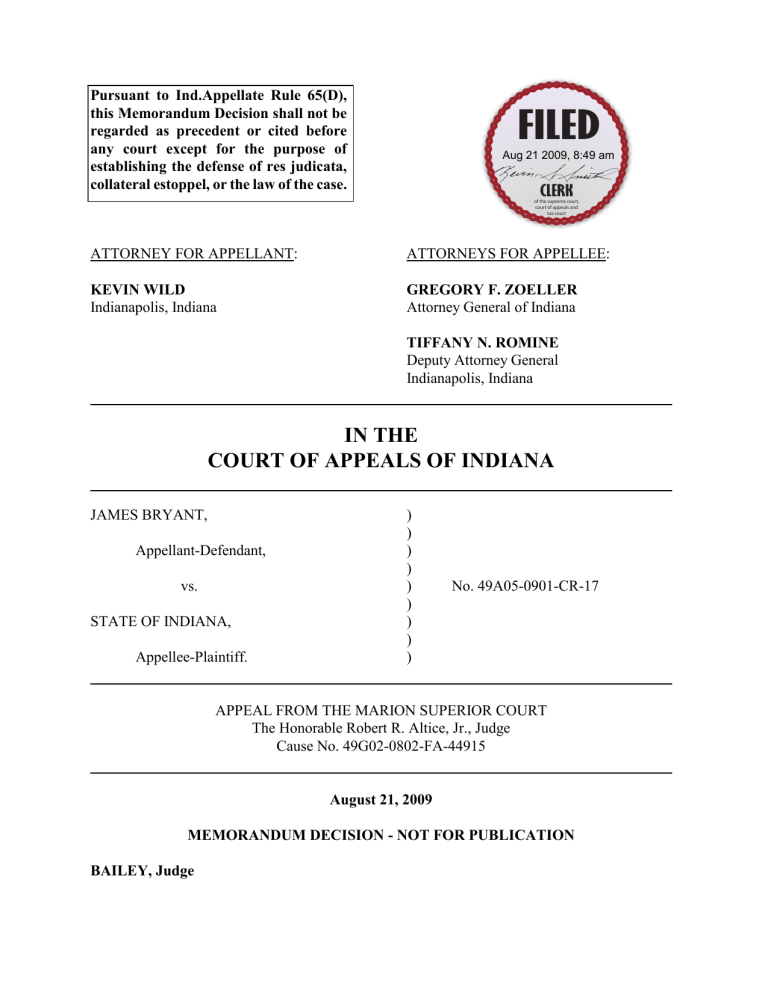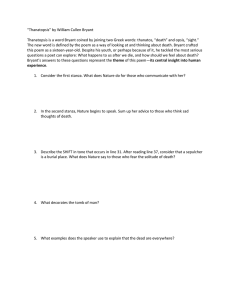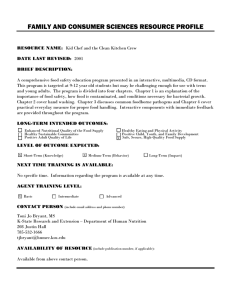James Bryant v. State of Indiana

Pursuant to Ind.Appellate Rule 65(D), this Memorandum Decision shall not be regarded as precedent or cited before any court except for the purpose of establishing the defense of res judicata, collateral estoppel, or the law of the case.
ATTORNEY FOR APPELLANT:
KEVIN WILD
Indianapolis, Indiana
FILED
Aug 21 2009, 8:49 am
CLERK of the supreme court, court of appeals and tax court
ATTORNEYS FOR APPELLEE:
GREGORY F. ZOELLER
Attorney General of Indiana
TIFFANY N. ROMINE
Deputy Attorney General
Indianapolis, Indiana
IN THE
COURT OF APPEALS OF INDIANA
JAMES BRYANT,
Appellant-Defendant, vs.
STATE OF INDIANA,
Appellee-Plaintiff.
)
)
)
)
)
)
)
)
)
No. 49A05-0901-CR-17
APPEAL FROM THE MARION SUPERIOR COURT
The Honorable Robert R. Altice, Jr., Judge
Cause No. 49G02-0802-FA-44915
August 21, 2009
MEMORANDUM DECISION - NOT FOR PUBLICATION
BAILEY, Judge
Case Summary
Appellant-Defendant James Bryant (“Bryant”) appeals his convictions for Burglary, as a Class A felony, 1 and Intimidation, as a Class C felony.
2 We affirm.
Issues
Bryant presents two issues for review:
I.
Whether there is insufficient evidence to support the Intimidation conviction because the State failed to establish his communication of a threat; and
II.
Whether there is insufficient evidence to support the Burglary conviction because the principal witness to the conduct of breaking lacked credibility.
Facts and Procedural History
Ashley Everman (“Everman”) first encountered Bryant when they were visiting a mutual friend. Bryant was present when Everman mentioned that she had earned $4,000 that week. As Everman was driving away after her visit, she looked up and saw Bryant standing in the doorway watching her leave.
Later, Everman was at the Indianapolis apartment she shared with her sister, cousin, and niece when she heard a knock at the door. In response to Everman’s inquiry, the person identified himself as “James.” (Tr. 61.) Everman cracked open the door but then, upon seeing several people congregated outside, attempted to shut it. Everman was knocked down as the door was shoved open.
1 Ind. Code § 35-43-2-1.
2 Ind. Code § 35-45-2-1(b)(2).
2
A black-hooded man, whom Everman recognized as Bryant, grabbed Everman by the throat and pushed her into the dining room where Andrew Allen (“Allen”) was seated. Two other hooded men, later identified as Curtis Brandon (“Brandon”) and Johnny Horton
(“Horton”), followed Bryant inside. Bryant, armed with a handgun, demanded money.
When Everman responded “what money,” Bryant struck her in the head with the gun. (Tr.
66.) Everman directed Bryant to her purse. Meanwhile, Horton robbed Allen of his cash.
Bryant and Brandon then took Everman upstairs, where her sister and her elevenmonth-old niece were in bed. Brandon pointed the gun at Everman’s niece, directing
Everman to cooperate so that her niece would not be hurt. Everman began to scream, awakening her sister, who surreptitiously dialed 9-1-1.
Bryant asked Everman which car belonged to her and she replied, “you know which car is mine.” (Tr. 81.) Bryant then struck Everman in the head with the gun a second time.
Bryant went outside to Everman’s car and returned shortly thereafter. Bryant tried to pull the rings from Everman’s fingers but was unable to do so.
Finally, Bryant and his accomplices used electrical cords to tie up Everman and Allen before they fled. Shortly thereafter, police officers apprehended Bryant, Brandon and Horton in the neighborhood and Everman identified them as the men who had robbed her. They were in possession of cash and various items that had been taken from Everman’s apartment.
On February 25, 2008, Bryant was charged with Burglary, Carrying a Handgun
3
without a License, 3 Pointing a Firearm, 4 four counts of Criminal Confinement, 5 Battery, 6
Robbery, 7 Intimidation, and two counts of Theft.
8 In a joint trial with Brandon and Horton,
Bryant was found guilty of all charges. The trial court entered judgments of conviction and sentences as follows: Burglary, thirty years, Carrying a Handgun without a License, one year, Pointing a Firearm, 545 days, two counts of Criminal Confinement, six years each,
Robbery, four years, Intimidation, two years, and two counts of Theft, 545 days each. The sentences were to be served concurrently, with the exception of one count of criminal confinement. Accordingly, Bryant received an aggregate sentence of thirty-six years. He now appeals.
Discussion and Decision
Standard of Review
Our supreme court has recently summarized our standard of review when assessing claims of insufficient evidence:
When reviewing the sufficiency of the evidence to support a conviction, appellate courts must consider only the probative evidence and reasonable inferences supporting the verdict. It is the fact-finder’s role, not that of appellate courts, to assess witness credibility and weigh the evidence to determine whether it is sufficient to support a conviction. To preserve this structure, when appellate courts are confronted with conflicting evidence, they must consider it most favorably to the trial court’s ruling. Appellate courts affirm the conviction unless no reasonable fact-finder could find the elements of the crime proven beyond a reasonable doubt. It is therefore not necessary
3 Ind. Code § 35-47-2-1.
4 Ind. Code § 35-47-4-3.
5 Ind. Code § 35-42-3-3.
6
Ind. Code § 35-42-2-1.
7 Ind. Code § 35-42-5-1.
8 Ind. Code § 35-43-4-2.
4
that the evidence overcome every reasonable hypothesis of innocence. The evidence is sufficient if an inference may reasonably be drawn from it to support the verdict.
Drane v. State, 867 N.E.2d 144, 146-47 (Ind. 2007) (quotations and citations omitted)
(emphasis in original).
Sufficiency of the Evidence - Intimidation
Indiana Code Section 35-45-2-1 provides, in relevant part, that a person commits
Intimidation when he “communicates a threat to another person, with the intent that the other person be placed in fear of retaliation for a prior lawful act[.]” The offense is a Class C felony if, while committing it, the person draws or uses a deadly weapon.
In Count XII, the State alleged that Bryant “did communicate to Ashley Everman, another person, a threat to commit a forcible felony, that is: to kill Ashley Everman, with the intent that Ashley Everman be placed in fear of retaliation for a prior lawful act, said prior lawful act being for not having relayed information to said defendants regarding where she was hiding her money, and while making said threat did draw or use a deadly weapon, that is:
waving a handgun in the air and/or pointing said handgun at Ashley Everman.” (App. 31.)
As such, the State alleged that Bryant threatened to kill Everman.
Bryant claims that his conviction must be vacated because he did not verbally communicate a threat to kill Everman; rather, it was his co-defendant Brandon who had urged, “Bro, you should just do her in.” (Tr. 79). The State responds that a threat may be communicated by conduct. The State is correct in its assertion. Indiana Code Section 35-45-
2-1(c), in relevant part, defines “threat” as “an expression, by words or action, of an intention
5
to: (1) unlawfully injure the person threatened or another person[.]” Thus, it was not necessary that Bryant verbally threaten Everman in response to her recalcitrance in revealing the location of her property.
Everman testified that Bryant twice struck her on her head with his gun when she was evasive in her replies to questions regarding her property. The blows, which were inflicted in response to Everman’s lawful act of non-disclosure, necessarily involved some waving of the handgun, as charged by the State.
9 Moreover, Bryant’s conduct took place as Brandon had accused Everman of lying and urged Bryant to kill her. Accordingly, there is sufficient evidence to permit the factfinder to conclude that Bryant had communicated a threat to
Everman with the intent that she be placed in fear of retaliation for her prior lawful act.
Sufficiency of the Evidence – Burglary
Bryant also claims that the Burglary conviction is not supported by sufficient evidence because Everman, the State’s principal witness, “is simply not credible and her testimony about Mr. Bryant’s entry into the house should not be believed.” Appellant’s Brief at 12. He points to Allen’s testimony that he heard Everman ask who was at the door and open it.
Bryant simply asks this Court to negatively assess Everman’s credibility and to resolve in Bryant’s favor perceived conflicts arising from the testimony of multiple witnesses.
However, the trier of fact, rather than this Court, is in the best position to weigh the evidence
9 We observe that Bryant was convicted of Pointing a Firearm, a Class D felony, for his conduct of pointing his handgun at Everman at some time during the sequence of events.
6
presented and to resolve conflicts, if any, arising from the testimony of multiple witnesses.
Graham v. State, 713 N.E.2d 309, 311 (Ind. Ct. App. 1999), trans. denied.
Conclusion
There is sufficient evidence to support Bryant’s convictions for Burglary and
Intimidation.
Affirmed.
VAIDIK, J., and BRADFORD, J., concur.
7



